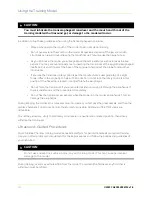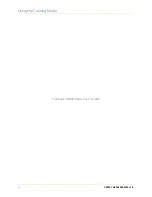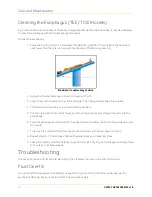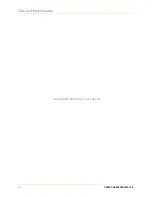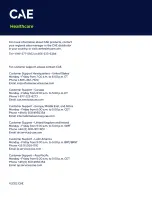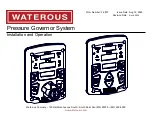
Using the Training Model
10
©2022 CAE 905K004752 v1.0
In addition, follow these guidelines when using the transesophageal transducer:
• Place a bite guard in the mouth of the model to aid in simulation training.
• Do not hyperextend the mouth on the model. Excessive extension of the jaw and mouth
structures can result in overstressing the mouth tissue. This will cause the tissue to tear.
• As you introduce the probe, you will experience the same anatomical structures as in a live
patient. You may encounter resistance to inserting the transducer at the epiglottis/esophageal
interface. Put your fingers at the base of the tongue to help direct the probe for smoother
introduction.
• If you use the transducer rotary controls per the manufacturer’s user guide to put a slight
forward flex in the probe tip to help with introduction, do not lock the rotary controls in this
position. If the flexed tip is locked, it can perforate the esophagus.
• Do not force the transducer if you encounter resistance moving it through the esophagus. If
there is resistance, end the procedure immediately.
• Do not flex the transducer excessively while the probe is in the model’s esophagus. This can
damage the esophagus.
During imaging, the cardiac structures will come into view as you first pass the great vessels, and then the
cardiac chambers. Full introduction into the stomach is possible. All standard TEE/TOE views are
obtainable.
To end the procedure, verify that all rotary controls are in a neutral and unlocked position, then slowly
withdraw the transducer.
Ultrasound-Guided Procedures
Your CAE Blue Phantom training model is a realistic platform for pericardiocentesis procedural training.
Use your normal protocol and equipment for these procedures, and follow the policies and guidelines of
your institution.
During training, users may withdraw fluid from the model. To maintain the fluid level, any fluid that is
withdrawn must be refilled.
CAUTION
You must lubricate the transesophageal transducer and the mouth and throat of the
training model with ultrasound gel, or damage to the model will occur.
CAUTION
Do not use antiseptics, such as iodine, on your training model. This can cause permanent
damage to the model.
Summary of Contents for Blue Phantom Echocardiography and Pericardiocentesis Ultrasound Training Model
Page 1: ......
Page 2: ......
Page 4: ...Contents ii 2022 CAE 905K004752 v1 0 THIS PAGE INTENTIONALLY LEFT BLANK...
Page 10: ...Introduction 6 2022 CAE 905K004752 v1 0 THIS PAGE INTENTIONALLY LEFT BLANK...
Page 16: ...Using the Training Model 12 2022 CAE 905K004752 v1 0 THIS PAGE INTENTIONALLY LEFT BLANK...
Page 20: ...Care and Maintenance 16 2022 CAE 905K004752 v1 0 THIS PAGE INTENTIONALLY LEFT BLANK...
Page 21: ......














